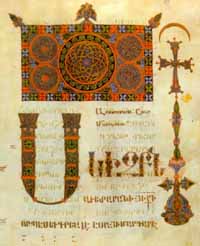Ani
By the early thirteenth century, when the kingdom had long
ceased to exist, the town of Ani still retained its significance
as a large trading centre where art, culture and various crafts
continued to develop under Zakarian dynasty. The few examples
of the Ani manuscript tradition that have reached us reflect
a new tendency in book illumination. It was a time when merchants
and craftsmen were beginning to play an important role in
the development of culture.
This new middle
class was not able to create huge monuments. And they were
no longer satisfied with simple folk art. Somewhere between
the two, they fostered a new tradition in manuscript art,
where they could commission stories with explanations and
side comments, completed with illustrations and ornamental
designs. It was an affordable, eye-catching art.
|

The
Gospels
1323, Horomos Monastery, near Ani
Written and illuminated by Ignatios
|
Works
by only two Ani illuminators - Markare and Ignatios - have
survived. This is an example of the Gospel of St. Mark,
by Ignatios, who worked in Horomos, during the first half
of the thirteenth century. Ignatios witnessed the beginning
of the Mongol invasion, and his painful experience was reflected
in the inscription he made on one of the manuscripts he
decorated: "In times of trouble and misery [was the book
written] when Ani was in the enemy's hands there was destruction
and devastation in towns and villages..."
|
Even
at the height of the Mongol invasion, some princes entered
into diplomatic negotiations with the invaders. The princes
of Siunik and Khachen in particular were able to secure relative
independence for their territories. A somewhat shaky peace
prevailed in the fourteenth century in parts of the country.
|


 |

